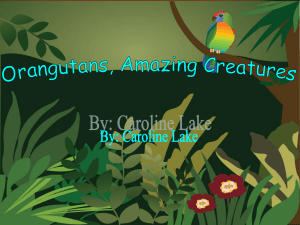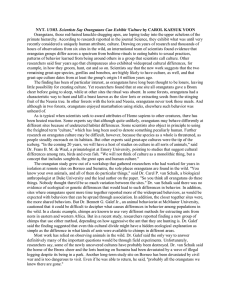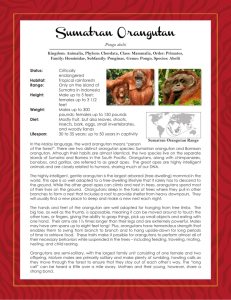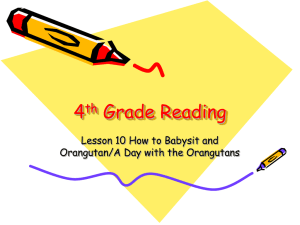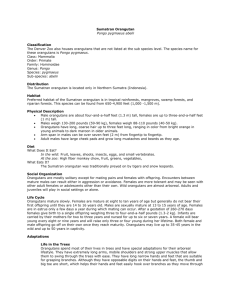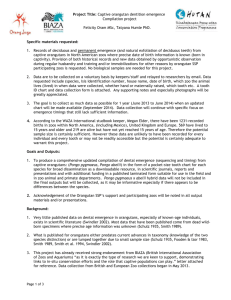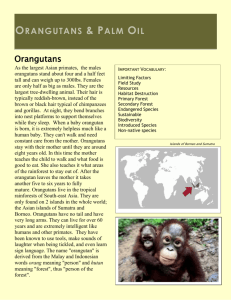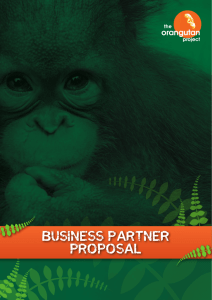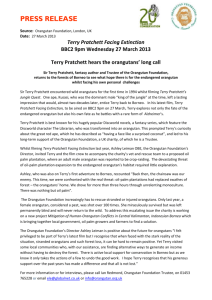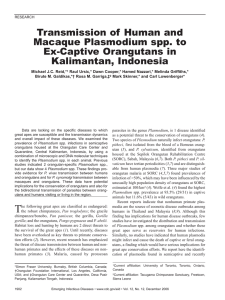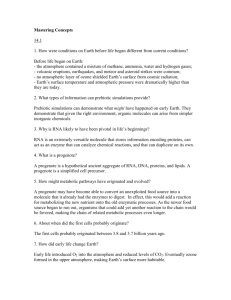Orangutans - MissCMGreenwood
advertisement
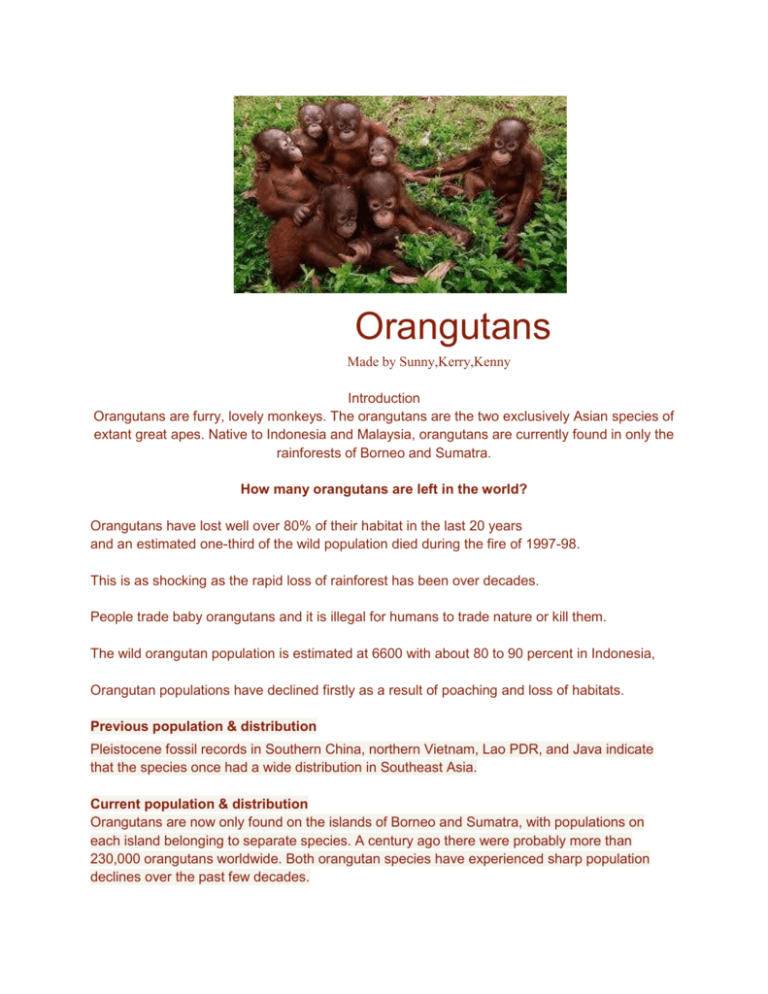
Orangutans Made by Sunny,Kerry,Kenny Introduction Orangutans are furry, lovely monkeys. The orangutans are the two exclusively Asian species of extant great apes. Native to Indonesia and Malaysia, orangutans are currently found in only the rainforests of Borneo and Sumatra. How many orangutans are left in the world? Orangutans have lost well over 80% of their habitat in the last 20 years and an estimated one-third of the wild population died during the fire of 1997-98. This is as shocking as the rapid loss of rainforest has been over decades. People trade baby orangutans and it is illegal for humans to trade nature or kill them. The wild orangutan population is estimated at 6600 with about 80 to 90 percent in Indonesia, Orangutan populations have declined firstly as a result of poaching and loss of habitats. Previous population & distribution Pleistocene fossil records in Southern China, northern Vietnam, Lao PDR, and Java indicate that the species once had a wide distribution in Southeast Asia. Current population & distribution Orangutans are now only found on the islands of Borneo and Sumatra, with populations on each island belonging to separate species. A century ago there were probably more than 230,000 orangutans worldwide. Both orangutan species have experienced sharp population declines over the past few decades. Threats The main threats in 2014 to the survival of orangutans is... of habitat through deforestation ● Illegal hunting ● Loss ● Illegal pet trade ● Palm oil The lowland forest habitats of Asia's only great ape are quickly disappearing. The are being cut down for timber or burned to make way for oil palm plantations and other agricultural developments. Pongo Pygmaeus is the scientific name for the orangutan.This unique animal that has a face just like man, lives in the forest. hutan' which literally means 'person of the forest'. Orangutans are a Great Ape along with gorillas, chimpanzees and bonobos. The Great Apes have large brains, forward-facing eyes and gripping hands. Humans are also Great Apes. In Fact: we share 96.4% of our genetic makeup with orangutans! The easiest way to distinguish between monkeys and apes is to look for a tail. Apes don't have tails whereas most monkeys male and female orangutans look different - they both have long red hair What they eat Orangutans eat mostly fruit - their favourites are huge spiky fruits called Durian Orangutans also eat some flowers, honey, bark, leaves and insects. Orangutans live in nest in trees (like birds) About 60% of the orangutan's diet includes fruit (e.g. durians, jackfruit, lychees, mangosteens, mangoes and figs), while the rest comprises of young leaves and shoots, insects, soil, tree bark, woody lianas, and occasionally eggs and small vertebrates. They obtain water not only from fruit Each of the two orangutan species is found only on the island from which it derives its name: Sumatra or Borneo. With numbers having fallen drastically over the past century and human pressures increasing, orangutans may be lost from the wild forever within a few decades. The orangutan is the world's largest tree-climbing mammal. The animals have a characteristic ape-like shape, shaggy reddish fur and grasping hands and feet. Their long arms that can reach as much as 2 meters in length. Orangutan's legs are relatively short and weak. But their hands and arms are powerful. There are 2 different types of adult male orangutan: "flanged" & "unflanged". Flanged males have a long coat of dark hair on their back, a facial disk, flanges and a throat sac used for “long calls". Both reproduce and an unflanged male can change to a flanged male for reasons that are not yet fully understood. The man of the forests Orangutans travel about by moving from one tree to another, and usually avoid climbing down to the ground - although there are differences between the two species. When on the ground, they move on "all fours", with clenched fists placed on the ground. Orangutans make a nest of plants to sleep in at night, and rest in smaller nests during the day to rest. Orangutans name means in Malay (person of the forest.) Adult orangutans live on their own. Life Cycle Orangutans usually give birth to a single young, or occasionally twins. After weaning at about 3.5 years of age, young individuals become gradually independent of their mother after she gives birth to a second young. Orangutan females first reproduce at around 10-15 years of age, depending on the species. Females give birth probably not more than once every 5 years. Habitat loss Habitat destruction and damage is by far the greatest threat to orangutans. Palm oil is in 50% of all supermarket food. Ranging from margarine, cereals, crisps, sweets and baked goods, to soap, washing powder, cosmetics. The habitat of Asias only great apes are fast disappearing under the chainsaw to make way for palm oil plantations. Orangutans are an easy target for hunters because they’re large and slow. They are killed for food or in retaliation. females are the food hunter for food in the family. This is where palm oil comes from. Conclusion Save the Orangutan! Here are some websites to visit... http://wwf.panda.org/what_we_do/endangered_species/great_apes/orangutans/ animals.nationalgeographic.com/animals/mammals/orangutan www.worldwildlife.org/species/oranguta www.savetheorangutan.org/
